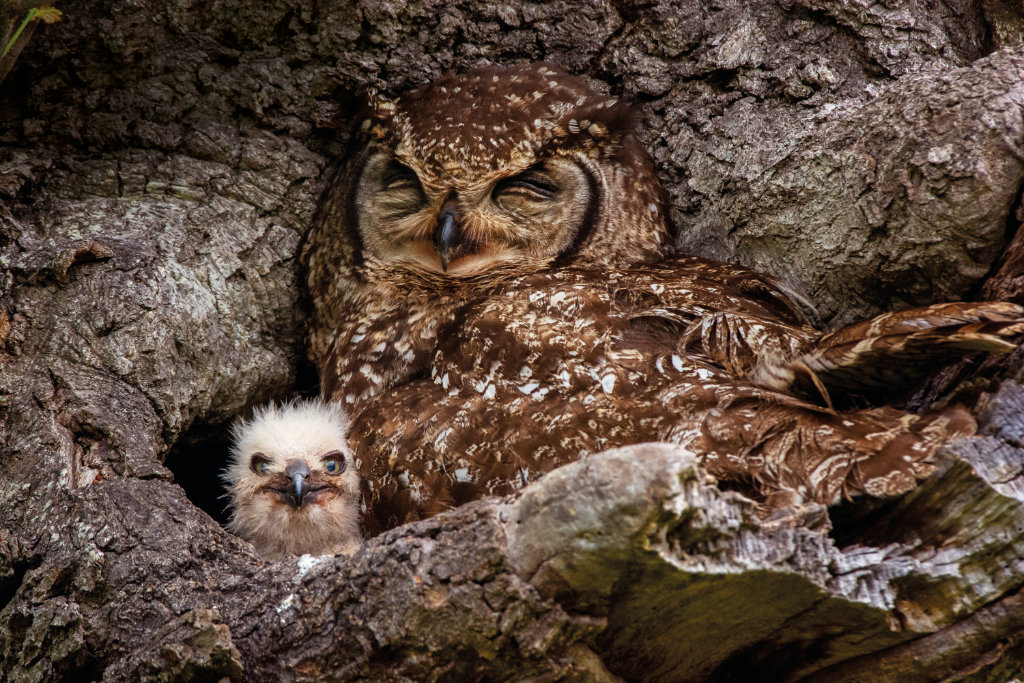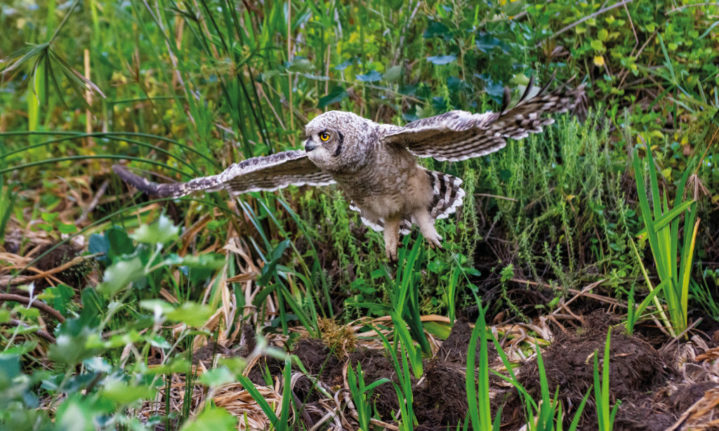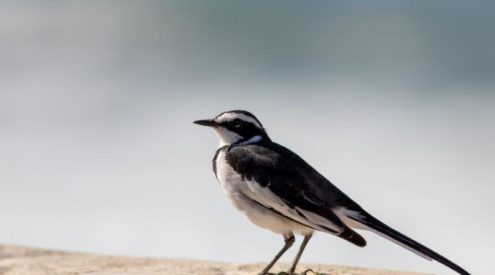Celebrity spotting in the mother city is a thing, especially if you’re a twitcher. Robert Ingle finds out what makes the region’s most famous owl family tick, and introduces us to their fanatical paparazzo.
Photography: Rob Mousley
Owls have a bad reputation in many parts of the world, including Southern Africa. Often regarded as malevolent agents, an owl sitting on the roof is taken as a portent of imminent doom. This is likely due to their nocturnal habits and silent flight, as well as the scream-like calls of species such as the barn owl. In fact, their fondness for rats, mice and cockroaches means they are highly beneficial for humans to have around, and their quiet flight is actually due to the structure of their feathers rather than any malign influence.

A star is born! The Noordhoek spotted eagle owlet at just over a week old. The female spent about 40 days straight, on the nest, being fed by the male owl.
The air turbulence produced by flapping wings usually generates sound. Owls have large wings relative to their size which allows them to glide, as well as special feather adaptations to minimise the sound produced when they do need to flap their wings. These include comb-like serrations on the feathers on the leading edge of the wing which break up air turbulence, and velvety feathers on their wings and legs which absorb any sound that is produced. This allows for the easier detection of prey moving around in the dark, as well as a stealthy approach.
Southern Africa is home to 12 owl species. These range in size from the diminutive African scops owl, which weighs in at 60 grams and has a frog-like ‘prrrpp’ call well known to Kruger park aficionados, through to the 2–3kg Verreaux’s eagle owl with its fetching pink eyelids. However, the species most familiar to South Africans is probably the spotted eagle owl. This is due to its widespread distribution and the fact that, unlike most other owls, it has adapted readily to urban areas; birds will be found wherever there are suitable open areas for hunting at night and roosting spots for them to hide in during the day.
Spotted eagle owls are large greyish birds with barring on the front and blotches on the rest of the body forming excellent camouflage for daytime roosting. Their two most prominent features are their piercing yellow eyes and large ‘ear’ tufts on the top of the head. In fact, these tufts have nothing to do with hearing, and their actual ears are on the side of their heads.

Named after the aviatrix Amelia Earhart, the owlet rapidly became proficient at flying, but not landing. There were many precarious moments as she attempted to alight on unsuitable branches.
Pairs often call to each other during the night with the male giving a double hoot to which the female will reply with a triple hoot. While they look alike, the sexes perform different roles during nesting with females responsible for incubation of the eggs while the male provides her with food. Both parents will then bring food to the young once they hatch.
Spotted eagle owls eat a wide variety of prey including insects, mice and rats, birds and reptiles. They devour their entire prey, regurgitating the indigestible parts such as bones some hours later. These pellets are an excellent way to find out what an owl has been eating and also to detect the presence of a roosting owl.
Cape Town is home to a number of celebrity spotted eagle owls, including a pair that nests in a hanging flower basket at the entrance to Kirstenbosch. But perhaps the most famous are the Noordhoek common owls, who have received international press coverage. Their fame is due to photographer Rob Mousley who has followed the activi ties of these birds with near religious devotion, reporting on them daily at @robmousleyphotography. A significant group of followers in Noordhoek (and far beyond) keeps tabs on the antics of these birds which have all the drama of a soap opera.
Tragedy struck when the adult female was killed by a car in January 2020 (a constant risk for birds hunting along roadsides) leaving behind two owlets that were still dependent on their parents for food. Relief followed when the adult male was able to provide sufficient prey for both his offspring to fledge successfully, and jubilation when he was able to attract a new mate a few months later.

At about a month old, the owlet developed wing feathers but was still covered in fluff.
This pair have nested successfully this year, and while one chick was lost early on, the remaining chick, named Amelia, is going strong. The nest site in a tree hollow provided an excellent platform for her to survey her many admirers below, in a manner somewhat reminiscent of a Roman emperor looking down imperiously on the commoners below. By late January she had (mostly) mastered flight but was still dependent on her parents for food, except for beetles scavenged while she was walking around.
If you’re in the Deep South it’s well worth a visit to see this endearing family. While the birds can be hard to find, Rob – armed with a giant camera lens – is much easier to spot and probably the surest way to find them.
Feathery facts
The Greek goddess of wisdom, Athena, was often associated with, or represented by, an owl symbol.
Because their eyes are fixed in position, owls must bob their heads around to build up a 3D image of their surroundings.
When facing forward, an owl can rotate its head up to 270 degrees in either direction, meaning that if it is initially looking at you over its back it can rotate its head a full 360 degrees.





















